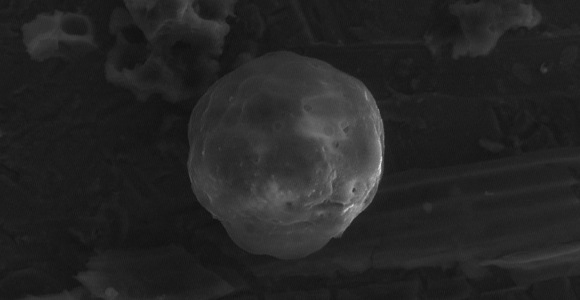When a large enough asteroid strikes the Earth, the devastation effects the entire globe. And the dinosaur-killing asteroid that smashed into the Yucatan peninsula 65 million years ago was no exception. According to researchers, just one outcome from the strike: carbon in the Earth’s crust was liquified and formed tiny beads that rained back down across the entire planet.
These beads are known to geologists as carbon cenospheres, and they’re produced during the burning of coal and crude oil. They’re a classic indicator of industrial activity. But 65 million years ago, there were no power plants, so scientists proposed that asteroid impact-driven forest fires could get hot enough to make them too.
As the asteroid struck, huge chunks of molten rock fell back to Earth, igniting forest fires across the planet. It’s here that scientists find evidence of charcoal from the fires, but not the cenospheres.
New evidence, reported in this month’s edition of the journal Geology, shows that natural fires can’t make the microscopic spheres.
Instead, the international team of researchers propose that they had to have been formed from an asteroid strike. A key additional piece of evidence is that the carbon cenospheres are deposited right next to a think layer of the element iridium.
It was this layer of iridium that helped to give scientists the evidence they needed to point to asteroids as the cause of the dinosaur extinction 65 million years ago. Since iridium is much more likely to be formed in the Solar System asteroids than in the Earth’s crust, a concentrated layer of the stuff had to come from off planet.
And the cenospheres have been discovered around the planet next to the iridium layer, in Canada, Spain, Denmark and New Zealand. The key discovery is that the cenospheres get smaller as you move away from the impact site. This matches the prediction that the heavier particles would rain back down to Earth closer to the impact, while the lightest particles would be carried across the entire planet.
The researchers were able to calculate the total amount of carbon injected into the atmosphere from an asteroid impact, and put the number at 900 trillion tonnes. This helps scientists get a better estimate of the impact size and damage.
Original Source: Indiana University


It was the Troodon’s Industrial Revolution and resulting Climate Change 65 million years ago that killed the dinosaurs. The asteroid impact was just co-incidence!
It would be interesting if not provocative to compare the amount of carbon cenospheres released from an astroid impact of this magnitude to the amount released from the past 100 years’ worth of industrial activity. My hypothesis is that industrial activity is giving an astroid impact a run for its money. Whatever the case, I’m willing to bet that the geologic record will give us clues as to what’s in store for us with the presence of a runaway carbon source…
900 trillion tons of carbon? Where did that much carbon come from? From the comet? From the Earth? If from the Earth, it had to be near the impact site.
Ah, wait a minute. The impact was into limestone — calcium carbonate. Case closed, other than where did the calcium end up?
900-trillion tonnes of carbon seems like a lot! 900-trillion tonnes of limestone which is certainly not pure carbon would be over 350,000 cubic kilometres of material if my calculations are correct.
I’m sure this is the wrong place to request this, but would it possible to put captions for the pictures on each story. This one actually looks like an artists rendition, but the filename implies it’s a photograph. Anyway, there have many times that I wanted more detail about a picture.
Thanx.
“Ah, wait a minute. The impact was into limestone — calcium carbonate. Case closed, other than where did the calcium end up?”
In healthy children’s teeth and bones.
Kendall
the photo appears to be an electron micrograph.
i read in UK free paper (Metro, May 9, 2008) that this exra/extraterrestrial carbon, under extreme conditions such as impact was partially converted to diamond.
This was preferentially assimlated into the (exo)skeletons of tiny deep-ocean dwelling organisms, possibly due to the extra weight & resilience, preventing them flooting upwards.